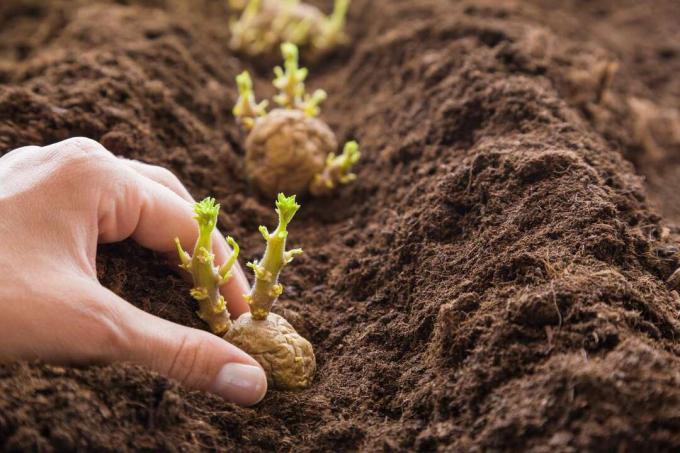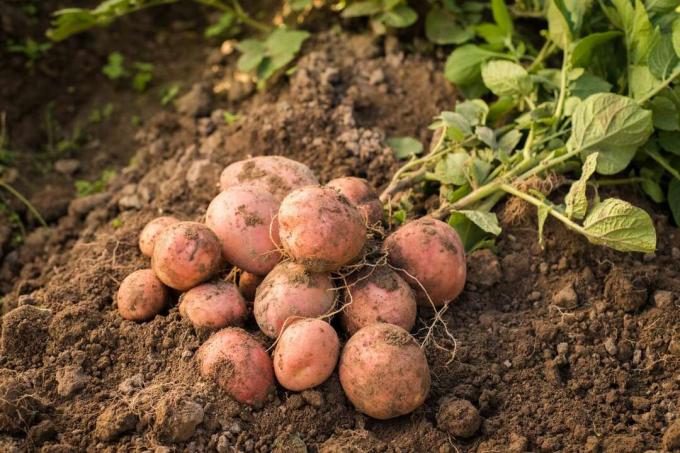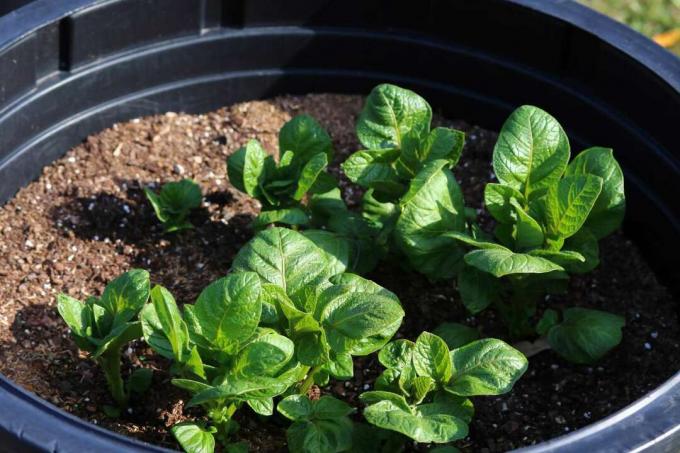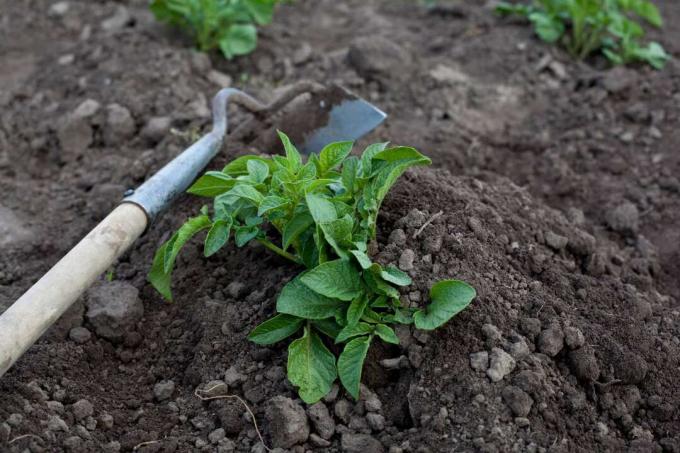When do you plant potatoes and what is the correct procedure for piling potatoes? With us you will find out how to plant and successfully grow potatoes.

Potatoes (Solanum tuberosum) are easy to grow in your own garden and are an important part of every self-sufficient garden. In addition to planting, piling up the potatoes is also an important issue. With us you will find out how you can successfully plant potatoes and which tubers are suitable for this.
contents
- Origin and properties of the potato
- Seed potatoes and seed potatoes: which potatoes can you plant?
- When do you plant potatoes?
- Planting potatoes: the right location
- Pre-germinate the potatoes
- Planting potatoes: distance and depth
- Planting and planting potatoes: instructions
- Pile up the potatoes
- Sowing potatoes: can you grow potatoes from seeds?
- Is the potato plant poisonous?
Origin and properties of the potato
The potato belongs to the nightshade family (Solanaceae) and is closely related to
tomato (Solanum lycopersicum) and aubergine (Solanum melongena) related. It originally comes from South America and arrived in the course of the 16th century. Century to Europe.But what does a potato plant actually look like? Potatoes usually reach a height of 60 to 100 cm. They form thick, juicy green shoots upwards from the subterranean, starchy tubers. The slightly to very hairy leaves are pinnate unpaired, 10 to 30 cm long and overhanging. In early summer from mid-June, the white, pink or purple flowers of the potato plant, which have grown together in five parts, appear. From these, inedible, tomato-like, green berries with the seeds of the potato ripen until late summer.
In addition to its roots, the potato forms numerous small tubers underground, which grow over the course of the summer. Depending on the variety and the weather, a yield of 700 to over 1000 g per plant can be expected.

Seed potatoes and seed potatoes: which potatoes can you plant?
What is the difference between normal table potatoes and seed or seed potatoes? Basically not at all - and there is no difference between seed potatoes and seed potatoes. If you want to grow potatoes on a large scale, you have to purchase the seed or seed potatoes from the breeder. The potato tuber falls under the Seed Protection Act. This means that the tubers that are intended for commercial cultivation must be distributed in a controlled manner. On the one hand, this ensures the breeder that his variety will not be propagated without his consent, and on the other hand, that no infected tubers and thus potato diseases are in circulation come. Seed potatoes in all shapes and colors are available by the kilo in gardening shops and from specialized growers.
Can you plant normal potatoes? With a hobby gardener, of course, a potato can accidentally fall out of the sack of table potatoes into the ground and form new daughter tubers there. However, many potatoes are treated with anti-sprouting agents so they don't start sprouting in the pantry. After application, the agent migrates into the tuber, so it cannot simply be washed off. Therefore, when buying potatoes, make sure that they are untreated. Such agents are generally prohibited in organic agriculture.
When do you plant potatoes?
Spring is the right time to plant potatoes - you can plant the tubers of the potato from the beginning of April to the end of May. At this point, the soil should be moderately moist to dry and loose. It is also important for cultivation to know the ripening time of the respective variety, i.e. whether it is New potatoes or Late potatoes acts.

Planting potatoes: the right location
In order for the potato to grow well, its soil requirements should be met and the optimal location should be chosen for cultivation. Potato plants prefer loose, well-drained and nutrient-rich soils in full sun. Sandy soils and sandy loam soils are ideal for this. But the potato also thrives in peaty and very loamy soils, as long as the water can drain off well. Waterlogging is not tolerated by it, because in this case the tubers rot quickly in the earth. A soil pH value of 5.5 to 7.0 is ideal. Plants can tolerate calcareous soils up to a pH of 8.5, but additional lime should be avoided.
Site and soil characteristics for growing potatoes:
- Loose, sandy, well drained and nutrient-rich soil.
- No soils that tend to become waterlogged, such as very loamy or clayey soils with poor drainage.
- Optimal soil pH between 5.5 and 7.0.
- Maintain crop rotation and change location from year to year.
- Alternatively, cultivation in pots with suitable potting soil.
In general, potatoes should never be grown multiple times in a row at the same location. They are only allowed to return to the same location after four years. This prevents ground-breaking Potato Diseases such as potato crab (Synchytrium endobioticum) as well as one-sided soil fatigue.
Alternatively, you can Plant potatoes in the pot and thus also cultivate on the terrace and balcony. A loose, well-drained and nutrient-rich potting soil like ours Plantura organic tomato & vegetable soil, is ideal for this.
Since the potato is a plant with a very high nutrient requirement, it is advisable to use legumes (Fabaceae) in the crop rotation in the year before potato cultivation Beans (Phaseolus vulgaris) or peas (Pisum sativum) to grow. These plants are able to fix atmospheric nitrogen in the soil and increase the nitrogen content in the soil. Winter greenery is also very suitable as a preculture for potatoes, as this brings a lot of organic matter into the soil. The combination with various other vegetables and herbs also has a positive effect on the soil quality and the yield of potatoes. Further advantages and ideal planting partners for one Mixed culture of potatoes you can find out in our special article.

Pre-germinate the potatoes
Seed potatoes can be pre-germinated on a light and warm window sill for four to five weeks from the beginning of March. This method ensures a harvest two to three weeks earlier and also enables cultivars with a medium ripening time to be grown. In this way you can usually even before the dreaded late blight (Phytophthora infestans) you are up to mischief, be harvested. However, you should make sure that the sometimes long shoots of the sprouted potato do not break off when planting in the ground.
Pre-germinate potatoes at a glance:
- Pre-germinate the potatoes from the beginning of March in a light place and at room temperature.
- Allows for an earlier harvest; can be a helpful method against late blight.
- Be careful when planting out the sprouted potato tubers: Do not break off the shoots!
Tip dividing the potatoes: Potato tubers can also be divided. However, this must be done before driving, i.e. around the end of February. It is best to cut up potatoes with a sterile, sharp knife and let the wound dry well. It is important that both halves have eyes - i.e. tiny buds. The shoots will later develop from these eyes. If you divide the tubers in good time, the potato has long enough time before planting out so that the wound heals and no pathogens can lodge.
Planting potatoes: distance and depth
When planting, the first question that arises is: How deep do you plant potatoes? Plant and row spacing also play an important role in bed planning. The optimal planting depth for potatoes is 6 to 10 cm, the planting distance between potatoes is 30 to 40 cm. The distance between the individual rows should be 60 to 80 cm.
Planting and planting potatoes: instructions
The planting season for potatoes begins from April to May. A planting shovel can be used to dig suitable holes for the tubers. Alternatively, make a long furrow with a garden hoe and place the potatoes in one after the other. Pre-germinated tubers are placed upwards with the existing shoot. Now cover the tuber with soil and water it. After a few weeks, the first green shoots will point out of the earth.

Pile up the potatoes
It is time to pile up the potato plants with soil when the foliage has already developed and grown to around 20 to 30 cm in size. After all, the tubers shouldn't turn green and bitter from sunlight. In addition, by piling up the potatoes, the yield can also be increased somewhat. The piled earth also forms roots along the shoot and thus improves water and nutrient uptake. The best way to combine the piling up with the weeding between the rows. Especially when potatoes are grown at an early stage, when the ground is still frosty, they can also be piled up prematurely to protect the foliage. Basically, it is advisable to carry out the piling in the evening, because then the foliage is oriented steeply upwards and the piled earth does not weigh the plant down. Here's how you go about piling potatoes.
Step by step: pile up the potatoes
- Correct time to pile up: When the shoots have reached an approximate size of 20 to 30 cm (also possible early in the case of early cultivation).
- Use a rake to pull the soil around the potato plant towards the plant so that a heap forms.
- Pile up soil around the potato plant so that the shoots are covered and only the tips of the shoots peek out.
- Remove weeds and thus eliminate competition for nutrients and water.
- The piling can be repeated if necessary.
Sowing potatoes: can you grow potatoes from seeds?
Basically, potatoes can also be grown from seeds, but in practice only growers do this. For the hobby gardener there are no advantages to sowing potato seeds. On the one hand, there is a high probability that the varieties were mixed during pollination. The next generation from the seeds is therefore probably not single-variety. On the other hand, seedlings take significantly longer to form tubers. The harvested tubers are quite small in the first year after the seeds are grown in February and therefore hardly produce any yield. Only when the harvest from the first year is planted in the following spring can the harvest volume be approximately comparable.

Is the potato plant poisonous?
The potato is poisonous to humans and animals in all green parts of the plant. Green spots on the tuber are also inedible. They contain the alkaloid solanine, which triggers typical signs of intoxication such as nausea, vomiting and drowsiness and, in high doses, can also lead to death. However, potato tubers without green spots are completely harmless and can even be eaten raw.
After planting and piling up, the regular Caring for the potato plant to be tackled. We'll give you tips on weed control, watering and nutrient supply.



